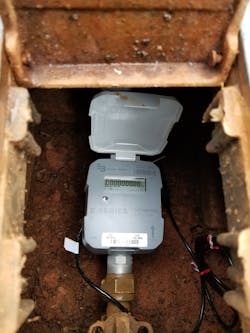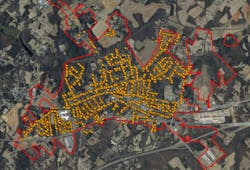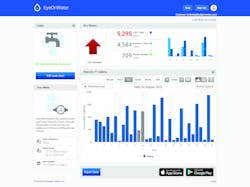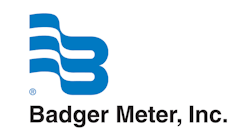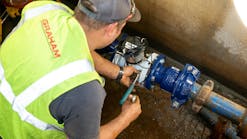Ultrasonic meters deliver smart savings for Rowan County
Located in North Carolina, Rowan County sits roughly halfway between Charlotte and Greensboro along the I-85 corridor. Salisbury-Rowan Utilities (SRU) was founded in 1886 as the Salisbury Water Company.
Over its nearly 140-year history, population levels increased and capacity needs grew, as did the utility’s assets. Today, SRU’s water assets include one water treatment plant treating an average of 9.3 million gallons per day, two wastewater facilities and 15 water tanks, for a finished water storage capacity of 7.455 million gallons. A total of 23,000 water customers in municipalities throughout Rowan County, including the city of Salisbury, as well as the towns of China Grove, Granite Quarry, Rockwell, Spencer and East Spencer, and several unincorporated areas, receive water from the utility.
In an effort to decrease non-revenue water and improve customer service, the utility completed an in-house meter analysis in 2012 and determined that a meter change-out project was necessary. At the time, the average age of existing meters was 17 years old, with some of the oldest meters in the system in service for nearly 50 years.Upgrading to ultrasonic
Upgrading meter infrastructure allowed the utility to gain more accurate data for employees to respond to customer inquiries about their bills and their usage, and to optimize operations and technological offerings in order to realize more revenue and improve overall sustainability.
“The water meter is our cash register, so we want to make sure that meter is as accurate as it can be,” said Jason Wilson, assistant utilities director for Salisbury-Rowan Utilities. “We determined that our meter age needed to be 14 years for us to maximize our accuracy and get the most life out of that meter. And so, at the start of this project, we were roughly 12,000 meters behind on change-outs that were necessary to maximize our system efficiency.”
Approximately 85% of the utility’s service area is residential, accounting for about 42% of the average daily billed volume of water. Prior to the meter upgrade project, the utility had seven meter readers working across the service area to compile data on a monthly basis, and change-outs happened as meters neared the end of their service life — about 500 meters annually. When a customer brought in a higher bill, SRU only had the information from the one monthly meter read available.
The city selected ultrasonic meters, cellular endpoints and software from Badger Meter. The company’s E-Series G2 Ultrasonic meters, paired with Orion Cellular endpoints and Beacon software as a service (SaaS), offer long-term, sustained accuracy, even in low-flow environments.
“Due to the extended flow range and electronics, ultrasonic meters can capture more data, such as the actual rate of flow in the service connection,” said Travis Smith, senior director of strategic marketing at Badger Meter. “They’re configurable, so, if there are changes in units of resolution that a utility wants to measure, the meter can be adjusted, and more alarms can be configured around the pressure and temperature data.”
Other benefits include leak detection and alerts for empty pipe conditions, meter removal or reverse flow conditions — all of which help the utility to react more quickly, efficiently and effectively to their devices within the field.Pilot provides proof
SRU partnered with Badger Meter to deploy a full-scale pilot project in the Town of China Grove. With roughly 10% of the entire water system assets located within the town’s borders, the utility expected the results from this pilot to provide a good idea of what deployment throughout the system might look like. They also hoped the results would garner support from the city council so a full meter change-out would get the green light.
“There were approximately 1,840 meters in China Grove, with four different reading systems including touch-read, two different drive-by systems and manual reads,” Wilson said. “A high rate of AMR failure meant that utility workers spent 128 hours per month completing meter reads. We wanted to really standardize on one solution, one system to get the town back on track.”
In 2014, nearly 1,800 E-Series Ultrasonic meters with Orion fixed network (SE) endpoints were installed over the course of 22 working days. Meter reading time was reduced to 12 hours a month, with hourly data transmitted via the Orion SE endpoints. Additionally, leak and tamper alarms alerted operators to anomalies in real time.
Based on the results of the China Grove pilot project, Wilson and his team estimated additional annual revenue for the utility to be about $785,000 per year based on more accurate meter reads. Because Salisbury-Rowan selected the Badger Meter software and endpoints deployed in the town of China Grove in a competitive process, the utility was able to sole-source the larger deployment throughout the service area without having to go out for bid again.
By this time, Badger Meter had added cellular endpoints to its portfolio, which allowed utilities to use an existing cellular network to transmit meter data. With the city council’s approval, SRU standardized and specified E-Series ultrasonic meters and cellular endpoints to be installed as existing technology failed or needed to be pulled to test, beginning with the deployment of 800 new Orion Cellular endpoints throughout the rest of the utility’s system.
“Cellular endpoints allowed us to ‘shotgun deploy’ the new system,” Wilson said. “We didn’t have to wait until we got to an area saturated with customers in order to justify putting up a collector. We found a cellphone tower to hook up with and immediately backhauled that data across the existing cellular network.”
In addition to improving accuracy and increasing revenue, another goal for SRU was to give customers access to their water usage data. With the EyeOnWater platform, both the utility and its customers have more data than ever before. Customers can create an account to view their own usage patterns, set up alarms and receive notifications for consumption that falls outside of their normal range. The utility can also proactively alert customers of high-volume events like a leak — in many cases before the customer would have noticed.
The data is key
SRU has streamlined account billing with uniform reading periods, which has standardized billing cycles and reduced the number of calls from customers about their water bills.
“The hourly data has helped us identify leaks, such as running toilets and stuck valves, by comparing water usage to operations,” said a plant manager for one of the town’s textile mills. “As consumption history builds, we plan to use trending patterns to forecast budgets and plan equipment upgrades. The water usage data has made an impact on how we look at our operations.”
Fewer meter readers out in the field means fewer trucks on the roads each month, which has helped reduce the utility’s carbon footprint. Employees can do more from the office than in the field, and more information has resulted in better planning. Wilson said the utility also realized a net savings of about 10% of current meter reading costs, even when factoring in monthly endpoint charges or those associated with the network as a service (NaaS) solution.
“Previously, we had seven meter readers that were manually collecting our readings each month for all of the water meters in the system,” Wilson said. “With AMI, there is more data to act on, so we needed to supplement field services in order to respond to alarms. We reclassified some of our meter reading positions to meter mechanics and meter service technicians. Through retirements or people taking jobs in other cities or other departments, no one lost their jobs.”Better accuracy, higher revenue
During the full system implementation and meter change-out, several customers noticed higher bills. This was for low-flow leaks that had previously gone undetected with old positive displacement or mechanical meters. Thanks to the ultrasonic technology, these leaks were identified and repaired, and utility revenue was recovered.
Due to increased meter accuracy, Salisbury-Rowan calculated an expected payback on their initial investment in less than nine years.
“We’re metering a higher volume of water,” Wilson said, “And we get paid on volume. So, if the water meters are our cash registers, we were putting in new, more accurate cash registers with ultrasonic metering technology.” WW

